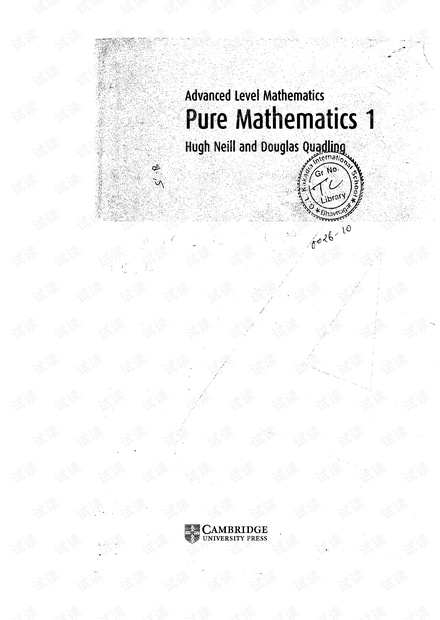Pure Mathematics -1 Advance Level.pdf
Cambridge International Examinations (CIE) Advanced Level Mathematics has been created especially for the new CIE mathematics syllabus. There is one book corresponding to each syllabus unit, exceptthat units P2 and P3 are contained in a single book. This book covers the first Pure Mathematics unit, 《纯数学 -1 高级水平.pdf》是针对剑桥国际考试(CIE)新数学课程大纲编写的一本教材。该书涵盖了高级水平数学的第一个纯数学单元,旨在帮助学生深入理解并掌握数学基础概念和技能。 书中内容丰富,包括了坐标、点与线的基本理论,这对理解几何图形和解析几何至关重要。此外,它还详细讲解了根式(surds)和指数运算,这是数学中的基本运算,对于处理复杂的代数问题必不可少。函数和图像是数学分析的核心,本书通过实例和练习介绍了各种函数的性质和图像绘制方法,这对于理解函数的动态行为至关重要。 二次方程部分不仅涵盖了标准形式的解法,还包括了不等式的处理,这对于解决实际问题和进行数学建模非常有用。在微积分章节,本书详细介绍了导数的概念及其应用,如速度、加速度的计算,以及利用导数求函数的最大值和最小值。同时,还探讨了序列和二项定理,这些都是高等数学中的重要概念,对理解无穷级数和幂级数有直接影响。 三角学章节讲解了角度测量、三角函数的性质以及它们在解决实际问题中的应用。接着,书中还涉及了函数的组合与反函数,这有助于培养学生的逻辑思维和抽象思考能力。在微分的扩展部分,介绍了二阶导数,它在判断函数凹凸性及极值点等方面起着关键作用。 积分作为微积分的另一重要分支,在本书中被详尽解释,包括定积分和不定积分的计算,以及积分在求面积、体积和物理问题中的应用。特别是旋转体的体积,这展示了积分在三维几何中的强大功能。此外,弧度制的引入使得角度测量更加精确,为后续的圆周率和圆的相关计算提供了便利。 本书还提供了多套复习练习题和模拟考试,以检验学习效果并提升应试能力。答案附录可以帮助学生自我评估,而索引则方便查找特定主题。 《纯数学 -1 高级水平.pdf》是一本全面覆盖CIE高级数学纯数学单元一的教材,它通过丰富的例题和练习,旨在提升学生的数学技能,为他们进一步探索更深层次的数学理论打下坚实基础。





剩余319页未读,继续阅读

 Raymondsam2020-09-23书本也太老了吧,2020年已经新大纲了,旧版可以淘汰。
Raymondsam2020-09-23书本也太老了吧,2020年已经新大纲了,旧版可以淘汰。
- 粉丝: 0
- 资源: 17
 我的内容管理
展开
我的内容管理
展开
 我的资源
快来上传第一个资源
我的资源
快来上传第一个资源
 我的收益 登录查看自己的收益
我的收益 登录查看自己的收益 我的积分
登录查看自己的积分
我的积分
登录查看自己的积分
 我的C币
登录后查看C币余额
我的C币
登录后查看C币余额
 我的收藏
我的收藏  我的下载
我的下载  下载帮助
下载帮助

 前往需求广场,查看用户热搜
前往需求广场,查看用户热搜最新资源
- 51单片机多路温度采集系统(二) C程序、proteus仿真、报告、仿真操作视频 实现对温度进行多路检测并准确显示 支持LCD1602循环显示当前8组温度值
- 四轮独立驱动电动汽车转矩分配控制 CarSim与Simulink联合 三自由度车辆模型(纵向、横向、横摆) 控制方法为离散LQR(包括连续系统的离散方法和求解方法) 带有完整详细的控制器、二自由度稳定
- MATLAB环境下一种基于模型的脉冲小波及其稀疏表示在轴承故障诊断中的应用 算法运行环境为MATLAB R2018A,将脉冲小波及其稀疏表示应用于轴承故障诊断 算法可迁移至金融时间序列,地震 微震
- MATLAB代码:电网-热网-气网的调度模型 目标函数:最小化火电发电成本、天然气源出力成本 电力系统中的机组包括传统燃煤机组、燃气机组以及CHP机组 负荷除了常规负荷外,还包括电锅炉 考虑39
- 基于滑膜控制的后轮主动(ARS)和DYC的协调稳定性控制,上层ARS产生期望后轮转角度,DYC产生横摆力矩Mz,下层采用基于附着系数和车速对附加横摆力矩进行分配,控制效果良好,能实现车辆在高低附着系数
- 多区温控程序,单区温控程序 温控仪表程序控制,MCGS通讯温控仪表控制温度升温工艺控制程序, 各种品牌PID仪表通讯触摸屏,30段温控程序,升温,恒温,降温,宇电控温工艺,岛电工艺程序,MCGS通讯
- 双闭环转速、电流直流调速系统的课程设计(MATLAB仿真) matlab simulink搭建的双闭环直流调速系统,电气模型,采用了ASR和ACR两个PI调节器,可以再保证系统稳定的条件下实现转速
- 智能软开关 主动配电网 优化运行 sop 规划 调度 配电网 重构 在电力系统运行中,智能软开关sop具有灵活地调节潮流和电压的能力 智能软开关sop是相较于传统联络开关提出的新的开关形式 智能软
- 多电压等级直流微店网母线电压控制研究 1、高频隔离DC DC变器模型(DAB-双有源全桥),基于MATLAB Simulink建模仿真 电压电流双闭环控制,功率双向流动,ZVS软开关 2、buck
- Modbus 主站 从站 在STM32单片机上的实现,企业在用的程序
- MATLAB代码:多源动态最优潮流的分布鲁棒优化方法 关键词:鲁棒优化;最优潮流;数据驱动;多源电力系统;不确定性 参考文档:《多源动态最优潮流的分布鲁棒优化方法》 仿真平台:MATLAB YALM
- 威纶通触摸屏与4台台达变频器485通讯,不经过pLc,有启动,停止,正转,反转频率输出,频率设定,电流输出,电压输出,DC-bus电压 马达转速
- 威纶通触摸屏与台达变频器485通讯,不经过PLC,有启动,停止,正转,反转频率输出,频率设定,电流输出,电压输出, 马达转速,运行状态
- MATLAB仿真-基于下垂控制的离网仿真 可观察负载突增下频率变化以及频率变化率 主电路为三相逆变器、LC滤波器、功率负载 控制方法为下垂控制 附带原理lunwen
- 默纳克系统升级工具烧录程序软件升级工具v3.14 v3.16 老国标烧录软件V1.26 Bootloader烧录工具V2.41 V3.10 一共5个烧录程序,软件升级
- 三菱FX3U PLC,三轴搬运程序,程序结构清晰 通俗易懂,注释齐全,控制三个台达B2伺服,信捷触摸屏程序,有电气CAD图纸


 信息提交成功
信息提交成功